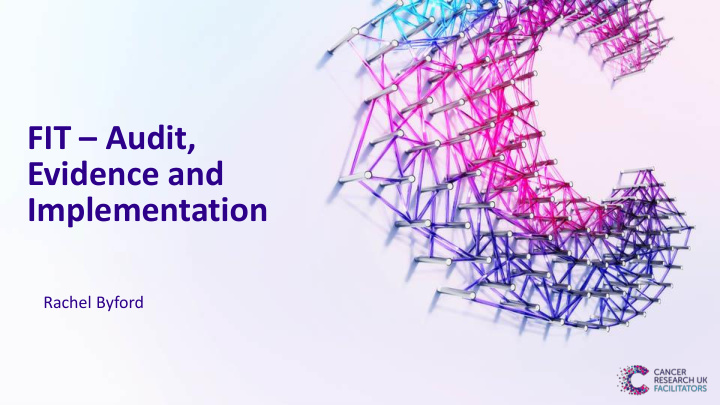



FIT – Audit, Evidence and Implementation Rachel Byford
Criteria for FIT as described in NG12 • 50y and over with abdominal pain and weight loss • Under 60y with change in bowel habit or IDA • 60y and over with anaemia, even in the absence of iron deficiency For patients with a positive FIT result NG12 recommends referral on a 2WW pathway DG30 recommends a threshold of 10µg/g
Why is FIT being recommended? - DG30 • “FOBT (in NG12) were intended to be used in selected groups of patients who have symptoms that could suggest colorectal cancer, but in whom a definitive diagnosis of colorectal cancer is unlikely, ie a low probability due to age and symptoms: PPV of between 0.1% and 3%.” • “ (Committee discussion) noted that in practice clinical history and current symptoms in this group of patients is heterogeneous, so management is likely to vary between individual patients and GPs…..(this is) due to the complexity of managing and investigating non- specific symptoms in practice.”
Comment on the quality of evidence for FIT in this cohort of patients – DG30 “(The committee) questioned whether data from studies included in the clinical effectiveness review were generalisable to the low risk population……noted that many of the studies were done in secondary care and included people with higher risk symptoms than those described in NG12. Clinical specialists…..although the populations in the studies were likely to have a higher prevalence of CRC the data provide evidence that FIT is likely to be highly sensitive for detecting haemoglobin in faecal samples. The committee concluded that although the differences in the populations introduced some uncertainty into the analysis, it was reasonable to include data in their review”
Devon FIT Audit Aims: • To estimate the number of patients that are eligible for FIT as described in NG12 • To increase understanding of how these patients are currently managed
Results • 217 patients identified in 9 practices over the course of 3 months • Mean of 14/1000 patients per practice each year (95% CI: 3.7 to 24.6) • Most patients presented with abdominal pain (either alone or with other symptoms) or anaemia
Secondary Care Referrals • Information relating to this was received for 119 patients • 48% were placed on a 2WW pathway • 20% had a routine referral • 12% were referred for USS • Other referrals included: – CT (direct access or urgent) – Emergency/urgent admission – CXR – MRI
Conclusions • Currently a proportion of the patients who meet the criteria for FIT in NG12 are being referred into secondary care on either a 2WW or routine referral • For some patients, FIT may be useful to help GPs decide the most appropriate 2WW pathway for the patient • Robust safety-netting processes will be used for those patients for whom FIT is negative, but whose symptoms persist/worsen
Recommend
More recommend